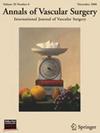重新审视金标准:Supera支架在股总动脉病变中的表现,中长期结果。
IF 1.4
4区 医学
Q3 PERIPHERAL VASCULAR DISEASE
引用次数: 0
摘要
目的:传统上,治疗股总动脉病变的方法是开放性股总动脉内膜切除术。然而,血管内技术的进步,特别是Supera支架(雅培血管公司)。CA, USA)是一种灵活、抗骨折的镍钛诺装置,提供了一种侵入性较小的选择。方法:我们回顾性分析了2021年1月至2023年6月在三家机构接受Supera支架治疗的33例有症状的CFA疾病患者。回顾了患者特征、手术细节和临床结果。主要终点包括1年、2年和3年的支架通畅、再次干预的需要、截肢或死亡率。结果:大多数患者(88%)表现为间歇性跛行;其余为严重肢体缺血。所有患者支架置入均成功;大多数手术通过交叉方法进行。在1年、2年和3年,原发性通畅率分别为88%、83%和79%。考虑到再狭窄病例的成功干预,在完全随访的患者中,初级辅助通畅率在3年达到100%。结论:Supera支架植入术似乎是一种安全、有效的替代开放式手术治疗CFA疾病的方法。虽然开放手术仍然是金标准,但我们认为Supera支架植入应该更常规地考虑,特别是在手术风险增加的患者中,等待正在进行的随机试验的进一步证据。本文章由计算机程序翻译,如有差异,请以英文原文为准。
Revisiting the Gold Standard: Supera Stent Performance in Common Femoral Artery Lesions, Medium-to Long-Term Results
Background
Traditionally, disease of the common femoral artery (CFA) has been treated with open endarterectomy. However, advances in endovascular techniques—particularly with the Supera stent (Abbott Vascular Inc. CA, USA), a flexible, fracture-resistant nitinol device—offer a less invasive alternative.
Methods
We retrospectively analyzed 33 patients treated with Supera stenting for symptomatic CFA disease at 3 institutions between January 2021 and June 2023. Patient characteristics, procedural details, and clinical outcomes were reviewed. Primary endpoints included stent patency at 1, 2, and 3 years; need for reintervention, amputation, or mortality.
Results
Most patients (88%) presented with intermittent claudication; the remainder had critical limb ischemia. Stent deployment was successful in all patients; most procedures were performed via a crossover approach. At 1, 2, and 3 years, primary patency rates were 88%, 83%, and 79%, respectively. Accounting for successful interventions in cases of restenosis, primary-assisted patency reached 100% at 3 years among patients with full follow-up. No amputations or device failures were observed.
Conclusion
Supera stenting appears to be a safe, effective alternative to open surgery for CFA disease. While open surgery remains the gold standard, we believe Supera stenting should be considered more routinely, especially in patients at increased surgical risk, pending further evidence from ongoing randomized trials.
求助全文
通过发布文献求助,成功后即可免费获取论文全文。
去求助
来源期刊
CiteScore
3.00
自引率
13.30%
发文量
603
审稿时长
50 days
期刊介绍:
Annals of Vascular Surgery, published eight times a year, invites original manuscripts reporting clinical and experimental work in vascular surgery for peer review. Articles may be submitted for the following sections of the journal:
Clinical Research (reports of clinical series, new drug or medical device trials)
Basic Science Research (new investigations, experimental work)
Case Reports (reports on a limited series of patients)
General Reviews (scholarly review of the existing literature on a relevant topic)
Developments in Endovascular and Endoscopic Surgery
Selected Techniques (technical maneuvers)
Historical Notes (interesting vignettes from the early days of vascular surgery)
Editorials/Correspondence

 求助内容:
求助内容: 应助结果提醒方式:
应助结果提醒方式:


